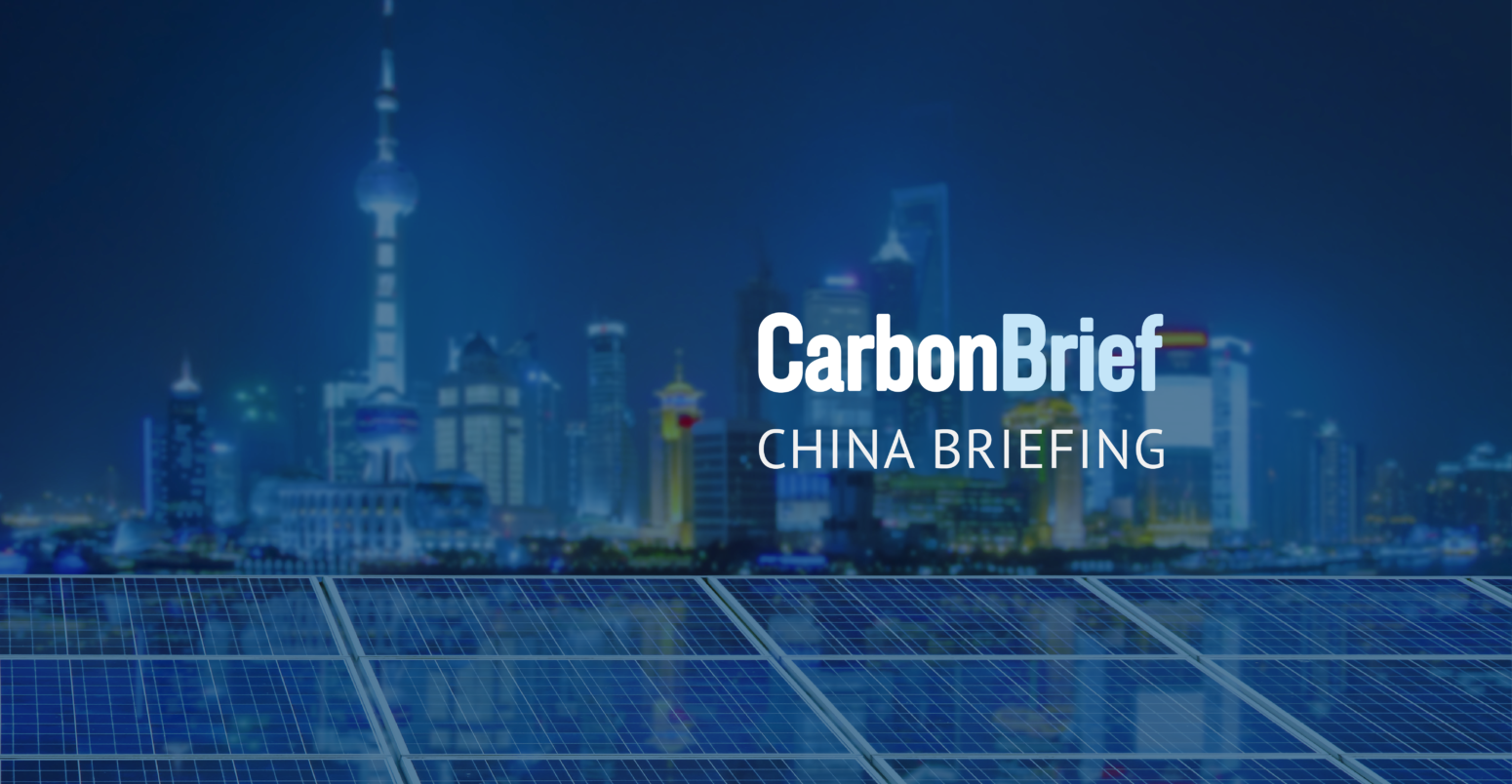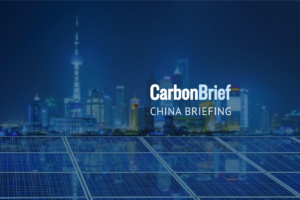
China Briefing 27 July 2023: Kerry in Beijing; ‘Collapsing’ hydro; ‘Soaring’ solar

Carbon Brief Staff
07.27.23
Carbon Brief Staff
27.07.2023 | 3:48pmWelcome to Carbon Brief’s China Briefing.
Carbon Brief handpicks and explains the most important climate and energy stories from China over the past fortnight.
Snapshot
KERRY IN BEIJING: The climate dialogue between China and the US is expected to continue, following US climate envoy John Kerry’s three-day visit in Beijing last week.
CHINA–EU UNITY: China and the EU said “climate adaptation, methane emissions management and control and the clean energy transition” are key areas of cooperation.

‘SURGING’ SOLAR: Government data showed solar installations reached 78 gigawatts (GW) in the first half of 2023, pushing total capacity to 470GW.
SPOTLIGHT: Carbon Brief explores the role of hydro in China’s energy supply after the country was hit by summer droughts for three consecutive years.
NEW SCIENCE: Peer-reviewed studies examined planted forest areas in East Asia and China, as well as the nexus between “green finance” and climate change.
Key developments
No breakthrough during Kerry’s visit to Beijing
TALKS RESUMED: US climate envoy John Kerry’s three-day visit in Beijing last week was the first substantive climate discussion between China and the US since Beijing cut off talks last August, after the then-speaker of US House of Representatives Nancy Pelosi visited Taiwan, the Guardian reported. Kerry’s meetings with various senior officials were expected to lay the groundwork for future potential pronouncements at events such as COP28, Bloomberg reported. Kevin Gallagher, director of the Global Policy Development Center at Boston University, told Politico that the dialogue between the two countries was the “best case” in the limited range of positive outcomes.
Sign up to Carbon Brief's free "China Briefing" email newsletter. All you need to know about the latest developments relating to China and climate change. Sent to your inbox every Thursday.
NO BREAKTHROUGH: Bloomberg quoted China’s climate envoy Xie Zhenhua saying that China and the US “share similar ideas” and “a similar past in addressing climate change”. Kerry, according to the Guardian, maintained that climate issues should be treated as a “free-standing” challenge that requires collective efforts from both sides. In a phone call with reporters, Kerry described his talks in Beijing as “very cordial, very direct and, I think, very productive”, although no significant breakthrough happened, the Washington Post reported. During the meeting with Kerry, Chinese premier Li Qiang stressed that developed countries’ responsibility should take the lead in “reducing emissions and fulfill[ing] their financial commitments”, while developing countries should “make contributions within their capacity”, said the Communist Party-backed newspaper People’s Daily.
RENEWABLES AND COAL: Kerry praised China’s progress on the deployment of renewable energies, but he warned that the new coal coming online “undoes the benefit of some of that”, Bloomberg reported. The abatement of methane and the reduction in reliance on coal were a crucial part of the talks, Reuters reported. Reuters also reported that Kerry said China was working on final approval to release details of its plans to curb methane emissions.
Xi stressed China decides own climate approach
DETERMINING OWN PATH: The frontpage of People’s Daily covered president Xi Jinping’s recent speech at a national conference on environment protection on climate change. According to the paper, Xi said the commitment to China’s “dual carbon” goal is “unswerving”, but China’s “approach, pace and intensity to achieve this goal should and must be determined by ourselves, and will never be influenced by others”. In addition, Xi stressed the importance of constructing a “clean, low-carbon, safe and efficient” energy system and an “innovative electricity system”, while enhancing the country’s capacity for energy security in oil and gas, reported state news agency Xinhua.
‘OLIVE BRANCH’: CNN reported that Xi’s remarks came during Kerry’s visit to Beijing. In response, Kerry said that the US is not “involved in dictating anything to anybody”, but “following the science”, Politico reported. Kate Logan, an associate director of climate at thinktank the Asia Society Policy Institute (ASPI), told Carbon Brief: “China won’t want to look like its hand is being forced”, but “new, joint action from China and the US could still be a strategic olive branch and lend credence to China’s rhetoric on being a cooperative international player on climate.” (For more, see Carbon Brief’s DeBriefed of 21 July.)
UPCOMING US TRIP: CNBC reported that Kerry told Chinese vice-president Han Zheng he hoped the two countries could “produce real results” at the Asia-Pacific Economic Cooperation (APEC) meeting this November. ASPI said in an email that, following Qin Gang being removed this week as foreign minister and replaced by his predecessor Wang Yi, “a key agenda item in US-China relations is whether the working and ministerial level can set the conditions for a successful visit of Xi Jinping to San Francisco for APEC”.
EU-China ‘climate cooperation’
JOINT STATEMENT: After the EU and China held the fourth EU-China High Level Dialogue on Environment and Climate (HECD) on 4 July, the two sides released a joint press release, declaring “both sides believe that green should be the most distinctive colour of EU-China cooperation”. The press release continued: “Climate adaptation, methane emissions management and control and the clean energy transition…were confirmed as key areas of cooperation”.
RECORD HEAT: On 16 July, a weather station in the northwestern region Xinjiang recorded China’s highest temperature ever – 52.2C – BBC News and China News reported. The record heat – and floods in southwest China – were among a string of extreme weather events affecting the world’s seven continents in July and catalogued by Carbon Brief.
Solar power capacity boosted in China
SOLAR SURGE: China’s solar power installations are expected to “surge” this year, with “the projected new installed capacity being raised from 95-120 gigawatts (GW) to 120-140GW”, according to data released by the China Photovoltaic Industry Association (CPIA), the state-run newspaper China Daily reported. (By comparison, new solar installation in the US was 20GW in 2022.) The upgraded forecast came as data from China’s National Energy Administration showed solar growth in the first half of 2023 reaching 78GW, pushing total solar capacity to 470GW. Meanwhile, exports of solar equipment in the first half of the year exceeded 207.8bn yuan ($29bn), a 13% year-on-year increase, Chinese financial outlet Caixin reported.
DOMINANCE AND COMPETITION: State-run newspaper China Daily quoted Jiang Yali from analysts BloombergNEF saying China accounts for more than 75% of the world’s total solar output. Wang Bohua, honorary chairman at CPIA, told news outlet Jiemian that there is a growing trend of solar exports. But Wang Zhenfu, a senior official from the ministry of commerce, said “external challenges”, such as trade remedies and tariffs, still exist, added the outlet. Maris Bakke, a senior analyst from research firm Rystad, told Quartz that “Europe is working to ramp up its own production of solar panels”.
Spotlight
China energy: More coal and less hydropower in 2023?
Last week, China announced a significant decline in hydropower output, largely due to ongoing drought. Carbon Brief explores the role of hydro in China’s energy plans and the environmental risks it faces.
Hydropower ‘collapse’ in 2023
On 17 July, China’s National Bureau of Statistics announced that, despite overall electricity generation growing 3.8% year-on-year, hydropower output fell by nearly 23% in the first half of 2023 – the largest drop among all electricity sources.
The Centre for Research on Energy and Clean Air recorded a “collapse” in output in the month of June, down 34% year-on-year. It attributed this to “drought and pressure to save water for generation during peak demand season in July–August”.
Coal power versus hydropower
This is major news for China’s electricity system and emissions – and for the world. Hydro is China’s largest source of renewable power, accounting for 15% of electricity in 2022.
The scale of the drop is so large that it eclipsed growth of other sources – wind and solar grew 16% and 7%, respectively – forcing an increased reliance on coal. Thermal power generation – largely coal – grew 7.5% in the first half of 2023, according to official data.
China sees coal as the “backbone” to provide energy security when renewable energy dips. The current drought is temporary; hydro will rebound and coal use will be tempered. Yet the policy response to another season with weak hydro output may have longer-lasting impacts.
Southwest China especially vulnerable
This year’s events come after two years of extreme summer droughts in 2021 and 2022. Coupled with an inefficient power system, these droughts – and the resulting drop in hydro output just as demand for cooling soared – led to power shortages that “wreak[ed] havoc” on daily life in southwest China, which is heavily reliant on hydro generation.
In Sichuan and Yunnan provinces, for example, hydro meets around 80% of annual electricity demand, according to the China Society for Hydropower Engineering.
In these provinces, 2023 was “20% drier” than 2022, according to the hydropower engineering society – and local governments are turning to coal in response.
For example, at the beginning of 2023, Yunnan started to implement its thermal reform policy, establishing an “independent thermal power market” for “energy security” and approving the construction of 4.8 gigawatts (GW) of mainly coal power plants.
Other provinces have also moved to increase their coal capacity – Guangdong approved 20.5GW of new coal-fired capacity in the first quarter of 2023.
Coal-driven climate impacts on hydropower
China is hardly alone in turning to coal during periods of drought, when hydropower output is reduced. A study of the US found that “switching from hydropower to fossil fuels during periods of drought … [cost] about $20bn” over two decades, due to high carbon dioxide (CO2) emissions, methane leakages, air quality-related deaths and financial expenses.
Yet this is not the only way that coal and hydro are intertwined: continued CO2 emissions from burning coal and other fossil fuels also affects hydro via climate change.
A 2022 review of hydro’s vulnerability to climate change pointed to depleted glaciers, reduced snow-melt runoff and increased precipitation extremes, water evaporation and water demand, as affecting the water levels needed for stable hydro supply.
A recent study by David Fishman and Mike Thomas at Lantau Group, an energy consultant group, found that “so-called ‘once in a century’ weather events [such as extreme droughts or flooding] are appearing with increasing frequency, intensity and regularity”.
They wrote that China “is now afforded the key opportunity to course-correct in real time, adding, enhancing and revising its grid to ensure that the power system is ready for the ‘new normal’ of 2023 and beyond.”
Future of hydropower in China
Notwithstanding recent shortages, China has the world’s largest undeveloped hydropower potential, according to the South China Morning Post. The country is continuing to develop large hydropower projects – despite resulting tensions with downstream neighbours, such as India.
Nevertheless, China’s “Action Plan for Carbon Dioxide Peaking Before 2030” emphasised that “we must insist [on] construction before destruction, stabilise energy stock and expand energy increment”, implying the country would not give up on coal easily.
This principle (先立后破) – sometimes translated as “build before breaking” – has been used in official pronouncements since 2021 (see Carbon Brief articles from 2021 and 2022 for background).
Taken to mean that new, low-carbon energy sources should expand before the use of coal starts to contract, the principle was mentioned again by president Xi Jinping in a national speech last week, delivered as US climate envoy John Kerry was leaving Beijing.
Dr Muyi Yang, associate director of clean energy at the Asia Society Policy Institute, agreed that hydropower generation will keep growing. However, he told Carbon Brief that “its relative importance may decline over time”.
In his view, China must build more low-carbon power capacity and, at the same time, work to better integrate generation, electricity grids, demand and energy storage.
Watch, read, listen
NATURAL DISASTER: China’s state broadcaster CCTV had an in-depth interview with Petteri Taalas, secretary–general of the World Meteorological Organisation (WMO), who said natural disasters in the next 30 years will be more “frequent”.
ELECTRIC CARS: The BBC produced a mini documentary on “Electric cars: What they really mean for you”, investigating if they are “good enough to replace petrol” and “the frustrations people face trying to charge their electric cars”.
CHINA–EU FUTURE: The Chinese financial outlet Caixin published a “weekend long read” of its interview with EU climate negotiator Frans Timmermans, exploring “what lies ahead for China-EU climate collaboration”.
UNPROFITABLE COAL: China Dialogue analysed the major financial losses seen in China’s coal power industry in recent years.
New science
Spatial database of planted forests in East Asia
Scientific Data
More than 87% of planted forest area in East Asia is in China – mainly in lowland tropical and subtropical regions and the Sichuan Basin – according to new research. The authors used “extensive in situ and remote sensing data”, as well as models, to produce the “first spatial database of planted forests for East Asia”. They estimated that there is almost 950,000 square kilometres of planted forest in East Asia. “Our findings inform effective decision-making in forest conservation, management and global restoration projects,” they added.
A systematic review on nexus between green finance and climate change: evidence from China and India
International Journal of Energy Economics and Policy
A new study traced papers published between 2018 to 2022 and found that “innovation in finance and technology are the major frontiers of green financing that are critical in addressing the problems of climate change”. “Green financial innovation” – such as green bonds or loans – is a “catalyst” for “green” technology innovation in energy, transport, construction and buildings, said the study. Environmental regulations “accentuate the process of green financial innovation and green technology innovation”, the study added.
China Briefing is edited by Wanyuan Song and Simon Evans. Please send tips and feedback to [email protected].

